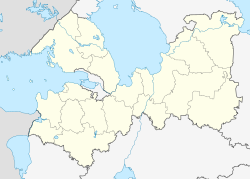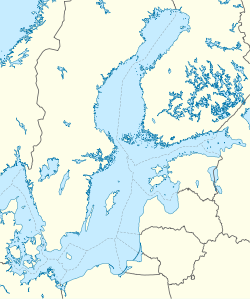-
A church in Primorsk, originally a Finnish Lutheran church designed by Josef Stenbäck, 1902–1904
-
Shore View from Koivisto, Hugo Simberg, 1907
-
Finnish Koivisto in 1934
Primorsk
Приморск | |
|---|---|
 Primorsk from bay | |
| Coordinates: 60°22′N 28°37′E / 60.367°N 28.617°E | |
| Country | Russia |
| Federal subject | Leningrad Oblast[1] |
| Administrative district | Vyborgsky District[1] |
| Settlement municipal formation | Primorskoye Settlement Municipal Formation[1] |
| First mentioned | 1268[2] |
| Town status since | 1940 |
| Elevation | 5 m (16 ft) |
| Population | |
• Total | 6,119 |
| • Capital of | Primorskoye Settlement Municipal Formation[1] |
| • Municipal district | Vyborgsky Municipal District[4] |
| • Urban settlement | Primorskoye Urban Settlement[4] |
| • Capital of | Primorskoye Urban Settlement[4] |
| Time zone | UTC+3 (MSK |
| Postal code(s)[6] | 188910 |
| Dialing code(s) | +7 81378[7] |
| OKTMO ID | 41615108001 |
| Town Day | Third Saturday of September |
Primorsk (Russian: Примо́рск; Finnish: Koivisto; Swedish: Björkö[8]) is a coastal town in Vyborgsky District of Leningrad Oblast, Russia and is the second largest Russian port on the Baltic, after St. Petersburg. It is located on the Karelian Isthmus, 137 kilometers (85 mi) west of St. Petersburg, at the northern coast of the Gulf of Finland, near Beryozovye Islands (Finnish: Koivusaari (Koivistonsaari), Tiurinsaari ja Piisaari; Swedish: Björkö) which are protected as a sea bird sanctuary. Population: 6,119 (2010 Census);[3] 5,332 (2002 Census);[9] 6,637 (1989 Soviet census).[10]
History
[edit]
Kingdom of Sweden 1293–1721
Russian Empire 1721–1811
Grand Duchy of Finland (Russian Empire) 1811-1917
Republic of Finland 1917–1918
Finnish Socialist Workers' Republic 1918
Republic of Finland 1918–1940
Soviet Union 1940–1941
Republic of Finland 1941–1944
Soviet Union 1944–1991
Russian Federation 1991–present
It was first mentioned in Russian chronicles as Beryozovskoye (Берёзовское, lit. birch settlement) in 1268, when the Hanseatic merchants from Gotland petitioned the Novgorod Republic to secure their passage to the Neva River.[11] The original Finnish name Koivisto means "a group of birch trees", "a birch forest". Swedish name Björkö means "birch island". Swedes annexed the region during the Third Swedish Crusade. Novgorod formally ceded the area to Sweden in the Treaty of Nöteborg in 1323. Thereafter Primorsk was organized under the control of the Fief of Viborg. It became a separate parish from the parish of Viborg in 1575.[12] The Russians retook the islands at the close of the Great Northern War in 1721. This was confirmed by the Treaty of Nystad in 1721.
In 1710, during the Great Northern War, the troops of Tsar Peter the Great included the whole area of the modern Vyborgsky District to Russia. In the course of Peter's second administrative reform, the area became a part of Vyborg Province of St. Petersburg Governorate.[citation needed] The 1721 Treaty of Nystad, which concluded the war with Sweden, finalized the transfer of this part of Old Finland to Russia.[2] In 1744, Vyborg Governorate, with the seat in Vyborg, was established.[13] After several changes, Vyborg Governorate was renamed Finland Governorate in 1802.[13] In 1811, it was renamed back and included in the Grand Duchy of Finland, which was previously ceded to Russia by Sweden.[13] In Finland, it became known as the Viipuri Province. On July 24, 1905, Wilhelm II of the German Empire and Tsar Nicholas II of Russia signed the Treaty of Björkö (Treaty of Koivisto) as a secret mutual defense accord.[14][15] In 1918, the Viipuri Province became a part of independent Finland.
Koivisto, together with the rest of the Karelian Isthmus, was ceded by Finland to the Soviet Union by the Moscow Peace Treaty as a result of the Winter War. It was recaptured by Finns in early September 1941 following the Soviet defeat at the Battle of Porlampi. The Finns held Koivisto during Continuation War but again ceded the town to the Soviet Union after the Moscow Armistice. This secession was formalized after signing Paris Peace Treaty in 1947. The population was resettled to Finland and population from Central Russia was moved to populate the Karelian Isthmus.
On May 16, 1940, Koivisto became the administrative center of the newly established Koyvistovsky District in Leningrad Oblast.[16] At the same time, Koivisto was granted town status.[citation needed] On October 1, 1948, the town was renamed Primorsk and the district was renamed Primorsky.[16] On April 3, 1954, Primorsky District was abolished and merged into Roshchinsky District, with the administrative center in Roshchino.[16] On January 4, 1957, Primorsk was transferred to Vyborgsky District.[17]

Primorsk evolved in the 20th century as an outport for the town of Vyborg.
Administrative and municipal status
[edit]Within the framework of administrative divisions, it is, together with twenty rural localities, incorporated within Vyborgsky District as Primorskoye Settlement Municipal Formation.[1] As a municipal division, Primorskoye Settlement Municipal Formation is incorporated within Vyborgsky Municipal District as Primorskoye Urban Settlement.[4]
Economy
[edit]Port of Primorsk
[edit]The town is the site of reportedly the largest Baltic Sea oil terminal, Port of Primorsk. It was developed as a terminus of the Baltic Pipeline System at a cost of two billion US dollars. The terminal started to operate in December 2001, supplanting Ventspils and other foreign rivals within one year.[18] In 2006, Primorsk was ranked first in Russia in crude oil export, with the export volume of 5,863,000 metric tons.[19]
In the wake of the 2022 Russian invasion of Ukraine, on April 29, 2022, Rosneft was not scheduled to export any diesel from Primorsk in May, as demand from Europe dropped off due to sanctions.[20]
Transportation
[edit]The town is on the railway line linking St. Petersburg to Vyborg. There is suburban train service to Finland Station in St. Petersburg.
The town is connected by roads with Vyborg and with Zelenogorsk and is also linked by bus to other localities nearby.
Notable people
[edit]- Eino Kirjonen, Olympic ski jumper
- Voitto Soini, professional ice hockey player
References
[edit]Notes
[edit]- ^ a b c d e f Oblast Law #32-oz
- ^ a b История Выборгского района, история Выборгской земли (in Russian). Муниципальное образование Выборгский район Ленинградской Области. Retrieved March 20, 2014.
- ^ a b Russian Federal State Statistics Service (2011). Всероссийская перепись населения 2010 года. Том 1 [2010 All-Russian Population Census, vol. 1]. Всероссийская перепись населения 2010 года [2010 All-Russia Population Census] (in Russian). Federal State Statistics Service.
- ^ a b c d Law #17-oz
- ^ "Об исчислении времени". Официальный интернет-портал правовой информации (in Russian). June 3, 2011. Retrieved January 19, 2019.
- ^ Почта России. Информационно-вычислительный центр ОАСУ РПО. (Russian Post). Поиск объектов почтовой связи (Postal Objects Search) (in Russian)
- ^ Телефонный код Приморска (in Russian). Телефонные коды всех городов Российской Федерации. Retrieved March 21, 2014.
- ^ Björkö names and Bjarkey law. See also article on Bjarkey laws for the name's probable connection to old Scandinavian trade legislation.
- ^ Federal State Statistics Service (May 21, 2004). Численность населения России, субъектов Российской Федерации в составе федеральных округов, районов, городских поселений, сельских населённых пунктов – районных центров и сельских населённых пунктов с населением 3 тысячи и более человек [Population of Russia, Its Federal Districts, Federal Subjects, Districts, Urban Localities, Rural Localities—Administrative Centers, and Rural Localities with Population of Over 3,000] (XLS). Всероссийская перепись населения 2002 года [All-Russia Population Census of 2002] (in Russian).
- ^ Всесоюзная перепись населения 1989 г. Численность наличного населения союзных и автономных республик, автономных областей и округов, краёв, областей, районов, городских поселений и сёл-райцентров [All Union Population Census of 1989: Present Population of Union and Autonomous Republics, Autonomous Oblasts and Okrugs, Krais, Oblasts, Districts, Urban Settlements, and Villages Serving as District Administrative Centers]. Всесоюзная перепись населения 1989 года [All-Union Population Census of 1989] (in Russian). Институт демографии Национального исследовательского университета: Высшая школа экономики [Institute of Demography at the National Research University: Higher School of Economics]. 1989 – via Demoscope Weekly.
- ^ Берёзовское-Бьёрке-Койвисто-Приморск (in Russian). Приморск - Информационный сайт. Retrieved March 21, 2014.
- ^ Hoppu, K. W.; Kansanaho, Erkki (1953). Koivisto - Sen vaiheista, asukkaista ja elinkeinoista (in Finnish). Porvoo: Koivikko-Säätiö. pp. 11–15.
- ^ a b c С. А. Тархов (2001). "Изменение административно-территориального деления России за последние 300 лет". Электронная версия журнала "География".
- ^ Fay, pp. 68-69. The treaty was published in Izvestia on December 29, 1917. On December 31, 1917, the treaty was copied in the Paris Excelsior. Afterwards, the treaty was copied (with slight paraphrasing) in narratives by Bompard, French ambassador at Petrograd 1902-08, and the Russian diplomat Anatoly Neklyudov.
- ^ Historical pictures from the German Bundesarchiv. Archived July 6, 2015, at the Wayback Machine
- ^ a b c Койвистовский район (май 1940 г. - октябрь 1948 г.), Приморский район (октябрь 1948 г. - апрель 1954 г.) (in Russian). Система классификаторов исполнительных органов государственной власти Санкт-Петербурга. Retrieved March 21, 2014.
- ^ Каннельярвский район (май 1940 г. - август 1945 г.), Райволовский район (август 1945 г. - октябрь 1948 г.), Рощинский район (октябрь 1948 г. - февраль 1963 г.) (in Russian). Система классификаторов исполнительных органов государственной власти Санкт-Петербурга. Retrieved March 21, 2014.
- ^ "Baltic lessons for EU in dealing with a resurgent Russia". Financial Times. November 24, 2006. Archived from the original on May 13, 2007. Retrieved November 24, 2006.
- ^ Fearnleys Russia Archived March 22, 2014, at the Wayback Machine. Russian tanker market monthly. October 27, 2006.
- ^ "Rosneft cuts diesel exports from key Russian port to zero". Reuters. April 29, 2022.
Sources
[edit]- Законодательное собрание Ленинградской области. Областной закон №32-оз от 15 июня 2010 г. «Об административно-территориальном устройстве Ленинградской области и порядке его изменения», в ред. Областного закона №23-оз от 8 мая 2014 г. «Об объединении муниципальных образований "Приморское городское поселение" Выборгского района Ленинградской области и "Глебычевское сельское поселение" Выборгского района Ленинградской области и о внесении изменений в отдельные Областные законы». Вступил в силу со дня официального опубликования. Опубликован: "Вести", №112, 23 июня 2010 г. (Legislative Assembly of Leningrad Oblast. Oblast Law #32-oz of June 15, 2010 On the Administrative-Territorial Structure of Leningrad Oblast and on the Procedures for Its Change, as amended by the Oblast Law #23-oz of May 8, 2014 On Merging the Municipal Formations of "Primorskoye Urban Settlement" in Vyborgsky District of Leningrad Oblast and "Glebychevskoye Rural Settlement" in Vyborgsky District of Leningrad Oblast and on Amending Various Oblast Laws. Effective as of the day of the official publication.).
- Законодательное собрание Ленинградской области. Областной закон №17-оз от 10 марта 2004 г. «Об установлении границ и наделении соответствующим статусом муниципальных образований Всеволожский район и Выборгский район и муниципальных образований в их составе», в ред. Областного закона №23-оз от 8 мая 2014 г. «Об объединении муниципальных образований "Приморское городское поселение" Выборгского района Ленинградской области и "Глебычевское сельское поселение" Выборгского района Ленинградской области и о внесении изменений в отдельные Областные законы». Вступил в силу со дня официального опубликования. Опубликован: "Вести", №27, 11 марта 2004 г. (Legislative Assembly of Leningrad Oblast. Oblast Law #17-oz of March 10, 2004 On Establishing the Borders of and Granting an Appropriate Status to the Municipal Formations of Vsevolozhsky District and Vyborgsky District and to the Municipal Formations Comprising It, as amended by the Oblast Law #23-oz of May 8, 2014 On Merging the Municipal Formations of "Primorskoye Urban Settlement" in Vyborgsky District of Leningrad Oblast and "Glebychevskoye Rural Settlement" in Vyborgsky District of Leningrad Oblast and on Amending Various Oblast Laws. Effective as of the day of the official publication.).








